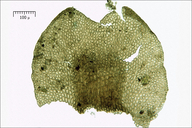|
|
click photo for larger file

Frullania tamarisci
Tamarisk Scalewort
|
Photographer: Dr. Amadej Trnkoczy
ID: 0000 0000 0223 0913 (2023-02-25)Copyright © 2023 Dr. Amadej Trnkoczy
|
|
INFORMATION PROVIDED WITH THE PHOTO
|
date of photo Feb 5, 2023
latitude 46.35935 longitude 13.70651
View on Google Maps.
location
Lower Trenta valley, between villages Soča and Trenta, right bank of river Soča, slightly downstream from the Otokar farmhouse, Trenta 4, East Julian Alps (Posočje, Slovenia)family
Frullaniaceae
notes Slo.: prava tamarišnica - syn.: Frullania nervosa Mont., Jungermannia tamarisci L. - Habitat: river bank, riparian forest, Picea abies and Salix eleagnos dominant trees, flat terrain; young, alluvial, calcareous deposits; in shade, high ground and air humidity; average precipitations ~ 3.000 mm/year, average temperature 6-8 deg C, elevations 535 m (1.760 feet), Alpine phytogeographical region. - Substratum: Fallen, dead (Fig. 1,2,4-6) and standing and alive (Fig. 3) trunk of Salix eleagnos. - Comments (pertain to pictures in Flicker album Frullania-tamarisci): Frullania tamarisci is a quite common liverwort. It can be found in very diverse habitats and substrata, but generally they love moisture. Most common substratum are calcareous rocks and boulders but tree trunks and sometimes ground are also included. All Frullania species are from far quite similar. Their color is not a reliable distinguishing trait among them. Most of them can be reddish, brownish, greenish and blackish depending on local conditions, habitat and moistness. In dry state, they look very differently than when moist. Usually, for reliable determination, one needs at least a good magnifier glass if not a dissecting microscope to observe tiny details of their leaves and other parts (or a long mileage regarding these 'mysterious' plants). - Frullania tamarisci can be recognized by its shiny appearance (in moist and dry state!), the shape of ventral (side closest to substrate) leaf lobes (they look like small jugs turned upside down, which are longer than wide) and by +/- linear row of special cells called ocelli on most or at least some leaves (see Fig. M5 and M6). Ocelli differ from regular leaf cells by slightly enlarged size, different color and by a single, large and grainy oil drop, replacing two or three smaller ones in the regular cells. In some species of the genus Frullania they are organized in rows. Ref.: (1) Smith A.J.E., The Liverworts of Britain & Ireland, Cambridge University Press (1991), p 253. (2) Paton, J.A., The Liverwort Flora of the British Isles, Brill, Leiden, Boston (2011), p 467. (3) Ian Atherton, (ed.), Mosses and Liverworts of Britain and Ireland - a field guide, British Bryological Society (2010), p 211. (4) https://www.britishbryologicalsociety.org.uk/learning/species-finder/ (accessed 23. 02. 2023)camera AmScope AM500 on Olympus CH20
contributor's ID # Bot_1505/2023_DSC02209 photo category: Plant - mosses/etc
|
MORE INFORMATION ABOUT THIS PLANT
|
| common names
Tamarisk Scalewort (photographer)
View all photos in CalPhotos of Frullania tamarisci Check Google Images for Frullania tamarisci |
|
The photographer's identification Frullania tamarisci has not been reviewed. Click here to review or comment on the identification. |
|
Using this photo The thumbnail photo (128x192 pixels) on this page may be freely used for personal or academic purposes without prior permission under the Fair Use provisions of US copyright law as long as the photo is clearly credited with © 2023 Dr. Amadej Trnkoczy.
For other uses, or if you have questions, contact Dr. Amadej Trnkoczy amadej.trnkoczy[AT]siol.net. (Replace the [AT] with the @ symbol before sending an email.) |
|
|
